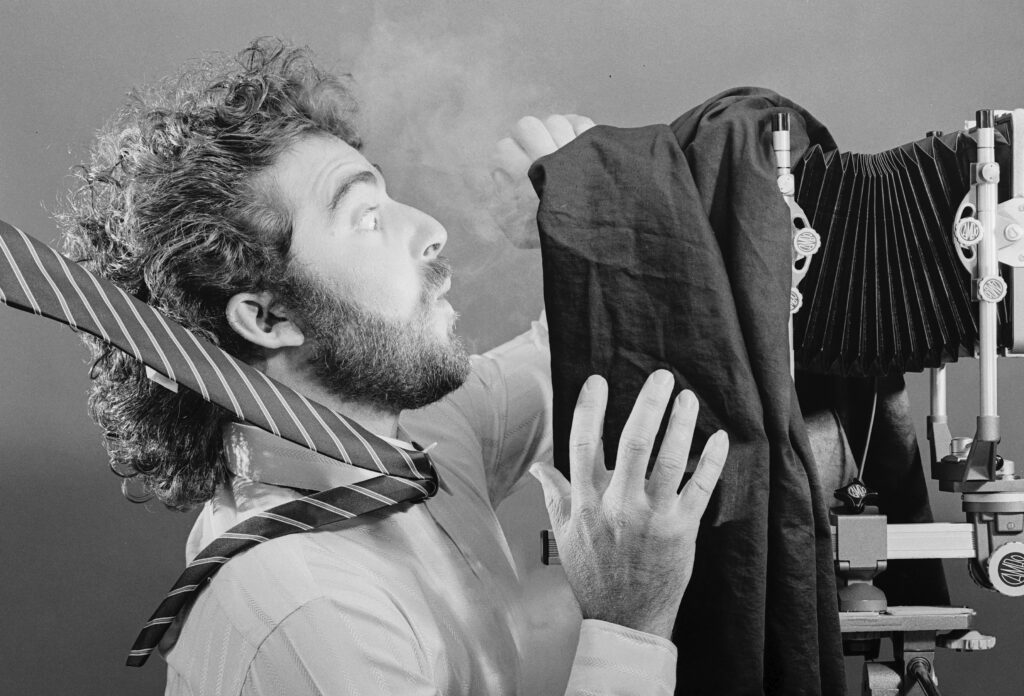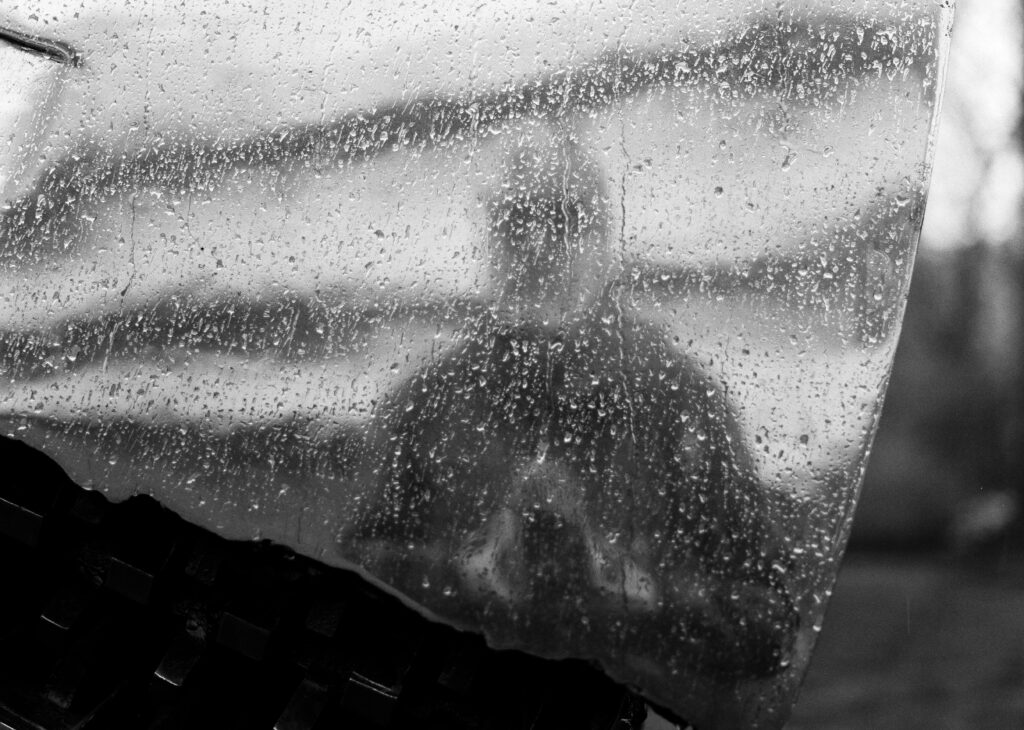For perspective, let’s rewind our brains.
In a long-forgotten time, on a planet called Earth, there were no self-driving cars, no 20MP cell phone cameras, no affordable drones, no internet and no ice cream. It was a seriously bleak place. Nobody knows the exact details of our existence back then because there was no way for people to record their lives. They were born, ate bland organic foods, reproduced – or not – and died leaving no record. Not a written word, not a photograph, and no sad garage sales for their kids to muddle through. Nothing. Zip. Nada. Then came stone tablets, pointy buildings in the desert, marble sculptures, and the pinnacle of picture production, the 4×5 camera.

Sure, I’m leaving some interesting inventions out, but let’s face it: Being barefoot, naked, and hungry was a low point, and being well-paid to shoot sharp photos on 4×5 film was humanity’s high point. For me. We can waive mirrorless toys with superzoom lenses all day, but everything began to go downhill – in my world – when I stopped getting paid to shoot 4×5. Damn, that was a good time! Advertising execs willing to spend their client’s money!

Back in the heyday I had a Linhof 8×10 camera too, for food shots, but the 4×5 Super Cambo was the ‘smallest large format’ camera in my stable. The 8×10 was a massively big heavy thing that needed an electric stand to hold it!

A 4×5 camera was reasonably portable and so darn fun to grandstand for clients. They loved to view a Polaroid and sign off on the shot with a Sharpie! It had way more mojo than my modern full frame DSLR. These days clients shoot over my shoulder with high end cell phones. It doesn’t take a mind reader to know what they’re thinking. “I can get that shot.”
It’s odd how their terrific cell phones have caused mine to stop ringing. Ugh. It’s my fault. They take my weekend cell phone photography classes.

Re: sharpness. We can argue megapixels, and one day affordable consumer cameras will be able to record 300+ MP images, but 4×5 film will still beat that number by any measure. Color 4×5 sheet film has at least 900 MP of ‘image data’ as characterized by ‘addressable pixels’ in the form of silver halides. The short-lived Kodachrome 4×5 (RIP) has been estimated at double that sharpness. But who’s counting? It’s an apples to oranges comparison. Bottom line: It doesn’t make a difference once you get to an equivalent of 100 MP because a negative that sharp produces a flaming good 20”x24” print.
Here’s a low-res scan of a 4×5 Ektachrome type B emulsion. I used tungsten lights for this shot. I miss the texture and warmth of 4×5 transparency films. I don’t get images like that with digital. It’s one of the last commercial shots I did on location with a 4×5 camera. Potter and artist, Dan Hennig, in his clay studio in Boulder Creek, CA. July, 1999.

I’m just shooting B&W these days, so for this discussion we’ll avoid speculation about comparisons and enjoy some recent results. What made me switch from shooting my full frame DSLR and return to large format B&W? How did I get here?
My college needed someone to teach a B&W film class. After interviewing people with master’s degrees in art, they weren’t getting what they wanted. Ideally, they needed an old-timer that loved the smell of Dektol in the morning. My dean casually asked if I would be interested. Of course I was!
The school darkroom has 15 Besler 23c useable enlargers, some with two lenses, enabling the use of 35mm and 120 negatives.

A local camera store donated an old Omega D-2 with all the condenser lenses and negative carriers for 35mm through 4×5. That altered the course of my photography life.

That, my friends, is when the author of this article relapsed and fell prey (again) to the allure of 4×5. It happened late one afternoon when the students had left the darkroom, and I had the place to myself. Jimi was singing Purple Haze on the boom box. I placed a nice old negative I’d taken of my dear departed mother into the Omega and made a test strip. As the image appeared in the developer, my heart started thumping. A spectacular print was soon to follow. I’m not a religious guy, but I imagine the rapture to be something like what I experienced.
This 4×5 photo of my mother was taken around 1980 with a Cambo Super and 210mm Symmar lens. What you see is a photo of the print. The copy shot was taken with a Nikon D-610 and an old Nikkor 55mm macro lens at ISO 800.

Is 4×5 really worth the effort? How sharp is it? As sharp as any full frame digital shot, but with creamy smooth gradations.

I already had loads of 4×5 negatives in my files, but that wouldn’t do. The photo-reptilian part of my brain wanted new, new, new images. A day outside with my current monorail 4×5 and Rodenstock 210mm lens was not satisfying. I dusted off a circa 1956 Linhof press-view camera with a Schneider 150mm and it was better, but unwieldly. Anything with a Linhof label belongs in the heavyweight division.

So, I began looking for lightweight 4×5 cameras that could accommodate my ailing 90mm Angulon, or better yet, a lens that has become a favorite of landscape shooters: The 65mm Super Angulon. If I could have that, everything in the world would be perfect. Almost.
Neither my brutish Linhof nor my Omega View could accommodate a 65mm. What was I to do? Sometime around 2 AM while my wife and dog slept soundly, I trolled the internet looking for a modern version of the ‘cigar box’ camera I had once rented. It had a 65mm Super Angulon mounted onto a wooden Cuban cigar box with a spring-loaded film holder mechanism on the back. It was sharp and it smelled great. I tried to buy it, but the guy wouldn’t sell. He was making too much money pimping it. I hoped there might be something similar on eBay. Stumbling through websites and reviews with bleary eyes, I happened upon a 3-D printed camera made in Norway with a version built for a 65mm Super Angulon! I ordered the specific model for a 65mm with the special helicoid focusing option. (That upgrade not shown here) I’d taken a big step, but that wasn’t enough.

My addiction craved more, so before going to bed I ordered a used 65mm lens from my friends at Seawood Camera in San Raphael, CA. When I finally laid down, I couldn’t stop twitching. Even the dog sensed something big was going to happen.

The lens arrived in a few days, but the wait for the 3-D camera was like two eternities. Morten, the camera manufacturer in Norway, indicated it would be a month to complete the order. The wait had me fondling the lens, mounting it onto a cardboard box to form silly images, and just plain anxious to get the camera. As soon as it came, I had it assembled and working in 15 minutes. It was better than I expected. It’s a very well-made camera for my purposes. I don’t need swings or tilts. I just want to point the lens at stuff and get great big negatives. My first images were everything I’d hoped for.
I used a 6-shot Grafmatic back like the one shown below.

Here’s the first image I took with the camera. My friend James is looking at a camera in his family’s antique store. 2 seconds f/16. He’s moving slightly, but everything else is sharp. All of the following photos were done with Ilford HP5 at ISO 800 using Rodinal 1:50 at 75f and printed. No scans have been made at this time. The copy shots were done on a Nikon D-610 with an old Nikkor 55m at ISO 800. As you can imagine, the prints glow and the copy shots don’t. Insert sad face emogee here.




This is a portion of the previous negative blown up to the equivalent of a 20”x24” print. When you blow up a sharp film image it gets grainy, not pixelated. If you’ve used a developer with high acutance, like Rodinal, the detail holds up better than digital with its jaggies and Macky lines resulting from over-sharpening. I’m sorry these examples don’t convey the print quality. Analog materials need to be seen in person.

The next photo is an inadvertent double exposure. I had taken a shot of a wall with my lens set at 1/400 @ f/16. I doubted it had exposed the film, so I reused the same frame on another scene. This is caused a ghostly blurring to the right and slightly below the bright part of the wall. When you’re out of practice with 4×5, stuff happens!

If anyone reading this article has bulky 4×5 cameras, think about removing the lenses and selling the gear while you can still get a few dollars for it, because this 3-D thing from Norway may change everything. It has for me!

I’m in rapture, whatever that means.
Share this post:









Comments
Paul Quellin on 4×5 reborn, or “What are those things?”
Comment posted: 25/09/2024
The images in the article are terrific. I particularly like the two shots inside the foundry. Thank you.
Comment posted: 25/09/2024
Tim Bradshaw on 4×5 reborn, or “What are those things?”
Comment posted: 25/09/2024
However you are wrong about one thing: the latter-day 3d-printed cameras are very convenient, but they have one major disadvantage over something made of wood and cloth. If you approach a stranger with a strange wooden camera and ask to take their photograph in return for a print, they *never* refuse: traditional wooden 4x5 field cameras are the ultimate tool for street portraiture. (And they don't have to be heavy: most of the weight of mine, with a 210mm lens, is the lens I think.)
Comment posted: 25/09/2024
Neil Ó Muirgheasa on 4×5 reborn, or “What are those things?”
Comment posted: 25/09/2024
The big problem with a 4X5 is getting it to to places where it can really be exploited - out in the broad and deep world of landscapes. But when you want fine detail, is there anything better - even when your focal and image planes are at normal configuration? Well, maybe an 8x10.
Wonderful photo of your mother.
Comment posted: 25/09/2024
Steviemac on 4×5 reborn, or “What are those things?”
Comment posted: 25/09/2024
Comment posted: 25/09/2024
Bill Brown on 4×5 reborn, or “What are those things?”
Comment posted: 25/09/2024
I love being able to read the small type in that sign. I'm ready to face my day now. Thanks!
Comment posted: 25/09/2024
Zheng Li on 4×5 reborn, or “What are those things?”
Comment posted: 25/09/2024
I happen to have a very similar one from WillTravel, and used it as my Point'n Shoot landscape camera. With 65mm lens, it is almost focus free.
Comment posted: 25/09/2024
Gary Smith on 4×5 reborn, or “What are those things?”
Comment posted: 25/09/2024
Comment posted: 25/09/2024
Jens Kotlenga on 4×5 reborn, or “What are those things?”
Comment posted: 25/09/2024
Thanks, Jens
Comment posted: 25/09/2024
Graham Orbell on 4×5 reborn, or “What are those things?”
Comment posted: 25/09/2024
Comment posted: 25/09/2024
Art Meripol on 4×5 reborn, or “What are those things?”
Comment posted: 25/09/2024
Great story and pix too.
Comment posted: 25/09/2024
Geoff Chaplin on 4×5 reborn, or “What are those things?”
Comment posted: 28/09/2024
Comment posted: 28/09/2024